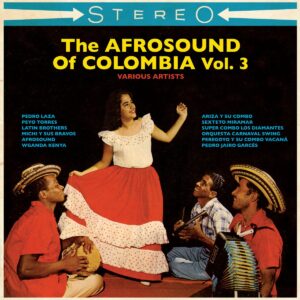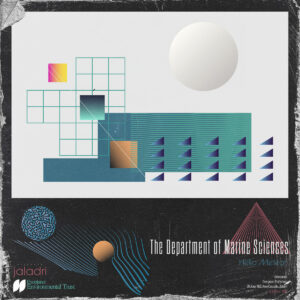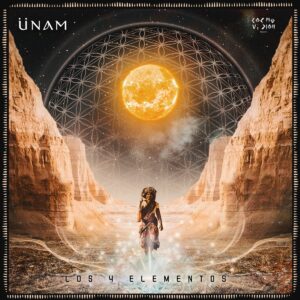Espuma de Mar by Barrio Lindo (Pre-Order)
In 2019, whilst touring Japan, Barrio Lindo found himself moving away from the dance floor,
instead getting lost in his headphones while listening to music that dismissed genre, oscillating
between jazz, chamber orchestras and electronica. As a producer at the forefront of Latin America’s
folktronica scene over the last 10 years, Agustín Rivaldo, to give Barrio Lindo his given name, has
proven himself more than adept at crafting soundscapes that can transport listeners, full of detail
and nuance, but they always had to pander to the club and its duty to keep revellers energised. The
epiphany in Japan necessitated a change in direction, to make music that people could get lost in,
and which also meant he could revert to his younger self, that guy in his twenties playing guitar
with his friends, just for fun. So he booked a studio on the outskirts of Buenos Aires in early 2020
and invited some friends over; the idea was simple, let’s play some music and see where it takes us.
Espuma de Mar is the result, those initial sessions refined over the intervening years, new
collaborators brought in where necessary, the production crafted in the same manner as his previous
electronic-focused output, but the feel here, the ambience, is completely different. Like the espuma
de mar, the sea foam that gives the album its name, this music has a fleeting quality, it arrives,
imperfectly, and never stops transforming; it replenishes, it diminishes, it breathes.
The biggest difference between this album and Rivaldo’s previous works is the increased tension,
and the sense of space; whereas beats and sequencers, as per their design, propel constant rhythm,
here every note has intent, only played if necessary to the composition. This is felt on “Llegada”, a
minimal groove soothed by kalimba thumb piano and fidgety synths while layers of trumpet take
the lead until a surprisingly sombre piano motif brings the song to a close. The title track has a
similar feel, whereby the music sounds improvised, each instrument free to roam, yet each note hits
you in the stomach; here, we get an ominous opener, spare notes of trumpet, charango, snare drum
and heavily-reverbed piano taking their turn until a rhythm begins to develop, albeit a rhythm that
refuses to retain its form, flutes, synths, bass and detached vocals all playing their part as the song
refuses to stand still.
Rivaldo has stated that it was the sounds of German-Senegalese group Mark Ernestus’ Ndagga
Rhythm Force and the UK-based project Hidden Orchestra that had the biggest impact on the
album’s sound, and it is certainly possible to see the affect of the latter in the mixture of field
recordings and percussive symphonic jazz. For this record, Rivaldo has worked with a small
ensemble of Nicolás Lapíne on trumpet, Ignus and drums and Federico Estévez on percussion, as
well as invitees such as flautist Mariana Iturri and violinist Alex Musatov. With Rivaldo himself
adding guitar, synth, bass and piano, the effect is of a modern chamber orchestra and the drama that
can bring. Opening track “Seguí” is a great example with its crashing piano chords and pulsating
violin, and there’s no denying the euphoria of a track like “Oasis”, whose woozy trumpets can’t
help but recall prime Beirut.
But there’s a reason Rivaldo is thought of so highly within the folktronica scene, and it’s for his
attention to detail. No two tracks on the album are the same, it goes from the percussion-heavy
“Migrante”, whose breakbeat and jerky synths show a love for hip-hop and 80s funk, to a beguiling
track like “Azufre” that has a vaguely-Caribbean cadence until a tenor sax solo from Camila Nebbia
takes it into more overtly-jazz territory. Then there’s a track like “Periferia” whose use of close-
mic’d percussion makes it feel like the speaker is literally shaking with rhythm, alongside “Tac Tac
Tac” that is full of warm, reverberant bass notes, albeit offset by hand claps and the only-discernible
vocal on the album. With this in mind, it should be no surprise that Rivaldo is also a luthier, using
some of the instruments he’s created on the album; there is a meticulous mind at work.
Espuma de Mar is that rare beast, an example of an artist reinventing themselves, yet somehow
sounding completely like they’ve always sounded. As Bandcamp once said in a feature on Barrio
Lindo, his music is “carefully composed, revealing an underlying sense of wonder and joy”, and
this continues on his latest, an album that is destined to provide someone else with an epiphany as
they get lost in the music on their headphones, whether that be in Japan or elsewhere.
releases September 23, 2022
Seguí:
Barrio Lindo: Synth, Sequencer, Piano
Alex Musatov: Violín
Ignus: Drums y Synth
Llegada:
Barrio Lindo: Kalimba, Bass, Sequencer
Ignus: Drums
Nicolás Lapíne: Trumpet
Migrante:
Barrio Lindo: Guitar, Bass, Synth
Federico Estevez: Drums & Percussion
Azufre:
Barrio Lindo: Keyboard, 7 string guitar
Camila Nebbia: Tenor sax
Ignus: Drums
Federico Estévez: Percussion
Perisféria:
Barrio Lindo: Kalimba, Piano & Synth
Ignus: Drums
Tac Tac:
Barrio Lindo: Bass, Sequencer
Fernando Lamas: Guitar, Troncófono, Vocals
Oasis:
Barrio Lindo: Sequencer, Tiple Colombiano & Synth
Mariana Iturri: Flute & Vocals
Nicolás Lapíne: Trumpet
Ignus: Drums
Recorded at Estudio Mudras (Buenos Aires) @ estudiomudras
Mixing & Mastering by Tatu Estela @tatuestela
Artwork: Elías Santis @eliassantis_
Design: Clau Smith @clau._.smith
Portrait: Constanza Rachi @cocorachi













